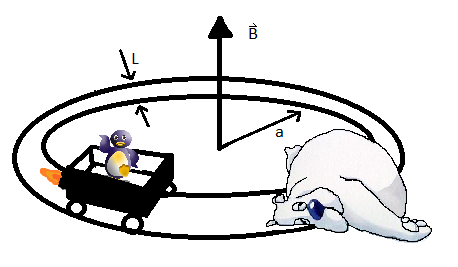Example: Metal Cart: Difference between revisions
Amy.crosby (talk | contribs) No edit summary |
Amy.crosby (talk | contribs) No edit summary |
||
| Line 17: | Line 17: | ||
<math> F_2 </math> can be found using Ampere's Law | <math> F_2 </math> can be found using Ampere's Law | ||
<math>\vec F=\int\limits_{c} I ~\vec dl\times \vec B~~~~~\ | <math>\vec F=\int\limits_{c} I ~\vec dl\times \vec B~~~~~\Longrightarrow~~~~~ \vec F_2=\int\limits_{0}^{L} I ~\vec dl\times \vec B ~~~~~\Longrightarrow~~~~~ \vec F_2=- I(t) ~B~L ~~ \hat i</math> | ||
We can also say that <math> I(t)=\frac{-e_m(t)}{R} </math> | We can also say that <math> I(t)=\frac{-e_m(t)}{R} </math> | ||
And <math>~~ {e_m(t)}= \int\limits_{o}^{L} (\vec v \times \vec B)~\vec dl ~~~~~\ | And <math>~~ {e_m(t)}= \int\limits_{o}^{L} (\vec v \times \vec B)~\vec dl ~~~~~\Longrightarrow~~~~~ {e_m(t)}=-v~L~B </math> | ||
<math> I(t)=\frac{v~L~B}{R} ~~~~~~~~~~~~~~~~~~~~~~\vec F_2=- I(t) ~B~L ~~ \hat i~~~~~\ | <math> I(t)=\frac{v~L~B}{R} ~~~~~~~~~~~~~~~~~~~~~~\vec F_2=- I(t) ~B~L ~~ \hat i~~~~~\Longrightarrow~~~~~\vec F_2=- \frac{v~L~B}{R} ~B~L ~~ \hat i ~~~~~\Longrightarrow~~~~~\vec F_2=- \frac{v~L^2~B^2}{R} ~~ \hat i</math> | ||
<math> \dot v=\frac{F_1}{m} ~\hat i~+\frac {F_2}{m}~ \hat i ~~~~~\ | <math> \dot v=\frac{F_1}{m} ~\hat i~+\frac {F_2}{m}~ \hat i ~~~~~\Longrightarrow~~~~~ \dot v= ~\frac{F_1}{m} ~~\hat i~- \frac{v~L^2~B^2}{R m}~~\hat i ~~~~~\Longrightarrow~~~~~ \dot v~ +~ v (\frac{L^2~B^2}{R~m}) ~-~\frac{F_1}{m}~=~0 </math> | ||
Now we have a differential equation to work with | Now we have a lovely differential equation to work with | ||
Revision as of 19:30, 25 January 2010
Problem
A DC generator is built using a metal cart with metallic wheels that travel around a set of perfectly conducting rails in a large circle. The rails are L m apart and there is a uniform magnetic field normal to the plane as shown in Figure 1. The cart has a mass m and is driven by a rocket engine having a constant thrust . A wet polar bear, having stumbled out of a shack where he recently had a bad experience with a battery, lays dead across the tracks acting as if a resistor R is connected as a load. Find The current as a function of time. What is the current after the generator attains the steady-state condition?
Solution
For this Problem we will represent the large circle as a pair of straight parallel wires and the cart as a single wire. This is illustrated below
FIGURE
We have two forces, being the force from the rocket engine and being the force caused by the current in the conductor and the Magnetic Field. The resulting Force is simply the sum of and
can be found using Ampere's Law
We can also say that
And
Now we have a lovely differential equation to work with
